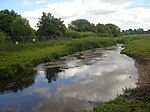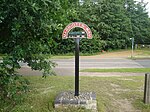Marriott's Way
EngvarB from May 2016Footpaths in NorfolkLong-distance footpaths in EnglandNorwichRail trails in England

The Marriott's Way is a long-distance footpath, cycle-path and bridleway between Norwich and Aylsham, Norfolk, England. It forms part of the National Cycle Network (NCN) (Route 1) and the red route of Norwich's Pedalways cycle path network. It is open to walkers, cyclists and horse riders. Its total length is 24.6 miles (39.5 km). It has a mixture of surfaces; tarmac, compacted gravel, and earth. The name of the route originates from the chief engineer and manager of the Midland and Great Northern Joint Railway (M&GNJR), William Marriott, who held the position for 41 years.
Excerpt from the Wikipedia article Marriott's Way (License: CC BY-SA 3.0, Authors, Images).Marriott's Way
Windmill Lane, South Norfolk
Geographical coordinates (GPS) Address Nearby Places Show on map
Geographical coordinates (GPS)
| Latitude | Longitude |
|---|---|
| N 52.6626 ° | E 1.2297 ° |
Address
Windmill Lane
Windmill Lane
NR8 5ED South Norfolk
England, United Kingdom
Open on Google Maps





